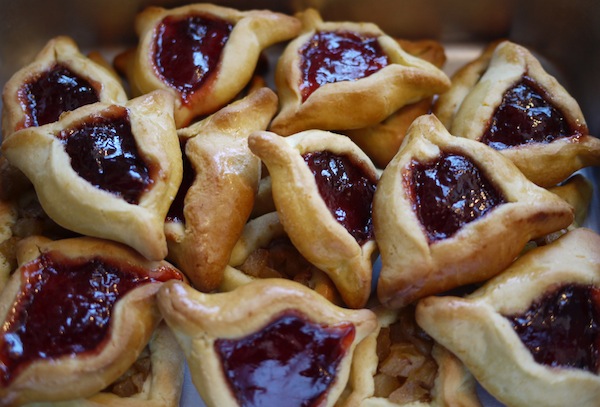While hamantashen are one of the most known Ashkenazi treats, many other foods are associated with Purim. (photo by Rebecca Siegel)
In the Book of Esther, all we are told is that letters were sent to the Jews in the provinces, telling them to have days of feasting and gladness. Fourth-century scholar Rava interpreted this to mean a seudat Purim, a meal in the late afternoon, to differentiate Purim from other days.
There are no rituals attached to the seudah, and no special Kiddush is said, though some people make up a Purim Kiddush, which is nonsense or a parody on something in the Torah.
Kalonymos ben Kalonymos, a French writer, philosopher and translator who lived in the 13th and 14th centuries, wrote a parody of a talmudic tractate, called Masekhet Purim, citing 30 different dishes to eat on Purim. He included chestnuts, duck, venison, goose and pigeon.
One custom, particularly of Jews of Middle Eastern backgrounds but also of some Ashkenazim, is to serve dishes with chickpeas on Purim. Why is this done? They say, in order to remind us that, to keep kosher, Esther lived on vegetables, notably beans and peas.
Another custom, according to the late Gil Marks in the Encyclopedia of Jewish Food, is to eat turkey, because Europeans had thought the bird came from India and the Book of Esther says Ahasuerus ruled from India to Kush. The Hebrew word for India, the country, and turkey, the animal, is hodu. Another idea is that the turkey bird is very foolish, and so was Ahasuerus.
Some people also serve kreplach, the triangular-shaped, meat-filled, savoury pastry on Purim. They do so because the meat inside is prepared by chopping, which is a form of “beating,” akin to the stamping of feet on the floor to drown out Haman’s name.
In the 17th century, European Jews made a dish called megillah kroyt, consisting of sauerkraut, raisins and honey. A stringy dish, it symbolized the rope used to hang Haman.
In her book Quiches, Kugels and Couscous, on Jewish cooking in France, Joan Nathan writes that Jews of Alsace made Alsatian Chouroute, sauerkraut with sausage and corned beef, because the sausage hangs in butcher shops and reminds them of Haman. The Alsatians also call the corned beef “the Haman.”
At the actual seudah, Marks says that Ashkenazim often serve koyletsh, or keylitsh in Russian – a long, braided challah symbolizing the rope on which Haman was hanged. Other Ashkenazi dishes include kreplach in chicken soup, knishes, pirogen (filled, boiled, pasta dumplings), stuffed roast chicken or veal breast, stuffed cabbage, and tzimmes.
Some Sephardim serve breads or foulares (pastries filled with long-cooked eggs), sambusak (meat turnovers), stewed chicken, and rice with chickpeas or nuts.
According to Encyclopedia of Jewish Food, because the name of G-d is not mentioned in the Book of Esther, “the sense of the mysterious and hidden extends even to the food.” In other words, we cannot see the fillings inside and that alludes to “the many intrigues, secrets and surprises unfolding in the Purim story.”
The sweets served on Purim symbolize a good “lot” and a sweet future. In fact, Muslims refer to Purim as Id-al-Sukkar, the Sugar Holiday.
The most important aspect of many Purim pastries is their shape. Most Ashkenazi Jews only know of hamantashen, the name for which comes from the German mohn (meaning poppy seeds) and taschen (referring to pockets). Some say the pockets refer to Haman, who stuffed his pockets with bribe money.
The original name was mohntaschen, and the tradition of eating them may date back as far as the 12th century. Shmil Holland, the Israeli historian, caterer and cook, says, when Jews fled Germany for Eastern Europe in the late Middle Ages, they took the poppy seed pastry with them and added the Yiddish prefix “ha,” thus making it hamantash. The Midrash, however, says, while reflecting on his plan to get rid of the Jews, Haman realized the three Patriarchs would intercede. Thus, the pastry is triangular in shape.
Sybil Kaplan is a journalist, lecturer, book reviewer and food writer in Jerusalem. She created and leads the weekly English-language Shuk Walks in Machane Yehuda, she has compiled and edited nine kosher cookbooks, and is the author of Witness to History: Ten Years as a Woman Journalist in Israel.

